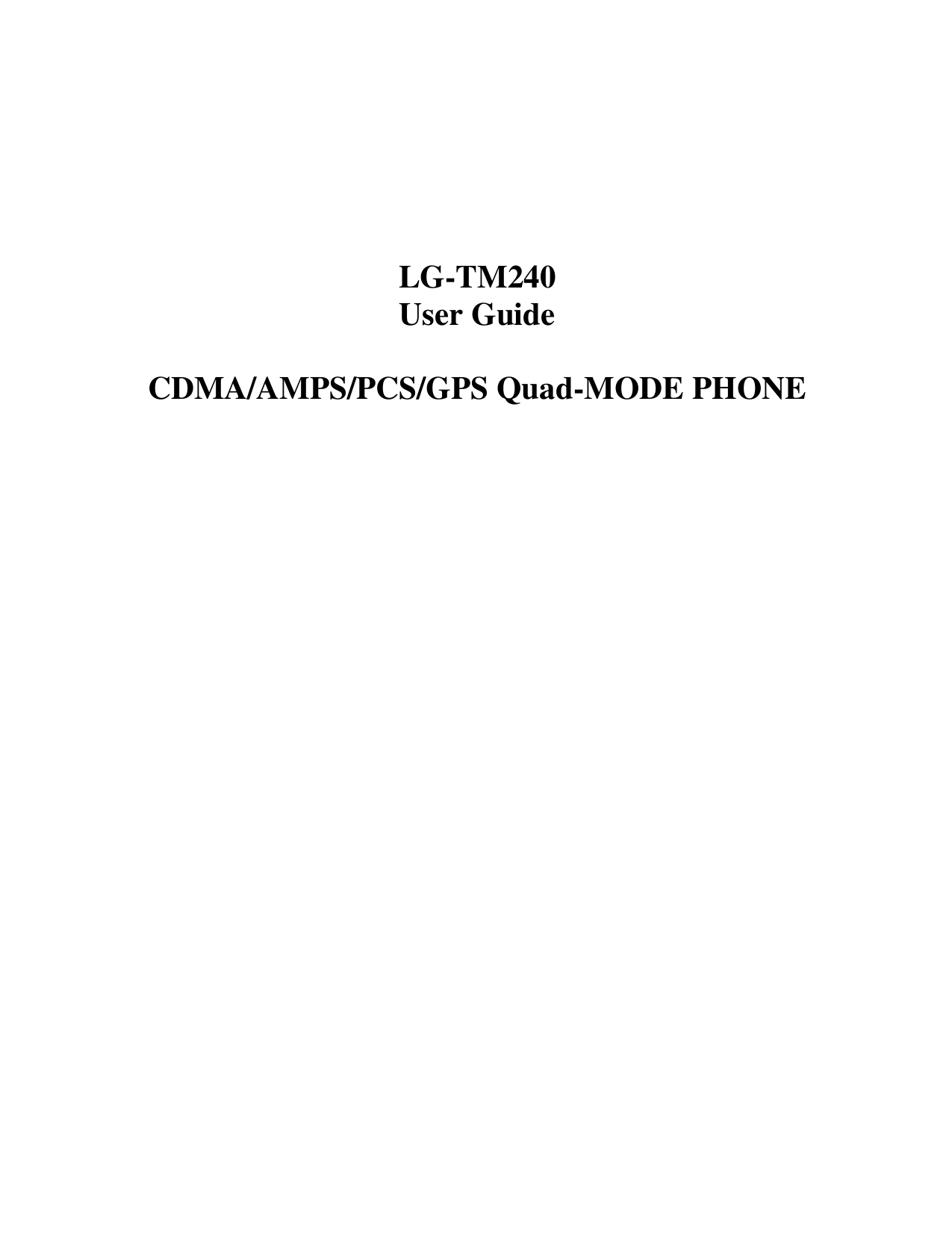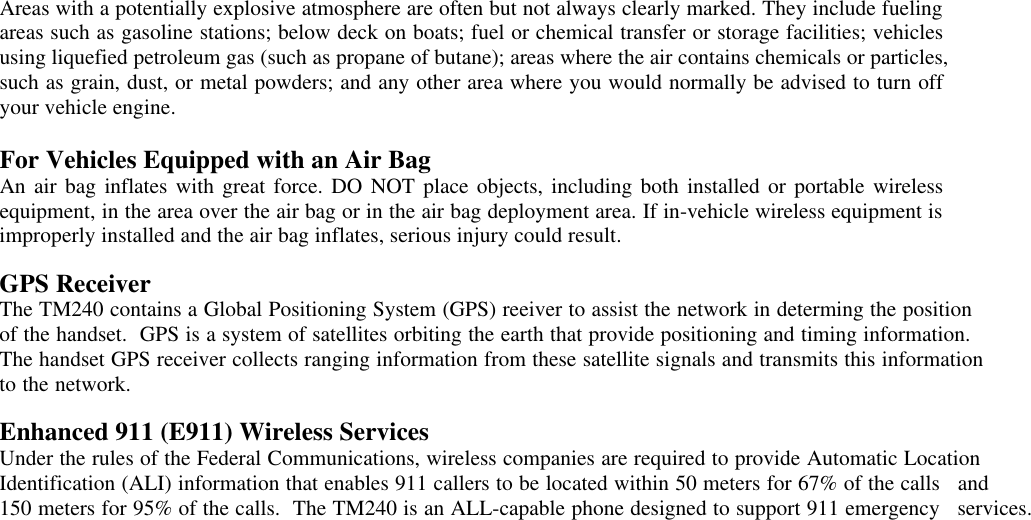LG Electronics USA TM240 Tri-Mode Dual-Band Analog/PCS Phone (AMPS/CDMA) User Manual TM240 UserGuide
LG Electronics USA Tri-Mode Dual-Band Analog/PCS Phone (AMPS/CDMA) TM240 UserGuide
Contents
- 1. Users Manual
- 2. Revised Users Manual per CRN 22730
Revised Users Manual per CRN 22730

![enhanced voice privacy mode. New SVC CFG (During a call : [MENU]+[5] ) Chapter 7. Accessories There are a variety of accessories available for the phone. You can select these options according to your personal communication requirements. Consult your local dealer for availability. Travel Charger This charger, model TC-10W, allows you to charge the battery pack. It supports standard U.S. 120Volt 60Hz outlets. While an orange light indicates that it is charging, a green light indicates charging is complete. It takes 5 hours to charge a completely discharged battery. Battery (LGLi-AAEM) Standard battery Desktop Charger The desktop charger, model DC-41W, allows you to place the phone for charging the stand. It can charge a completely discharged battery in 3 hours. Cigar Lighter Charger You can operate the phone and trickle charge the phone’s battery from your vehicle by using the cigarette lighter charger, model CLC-11W. It takes 5 hours to charge a completely discharged battery. Hands-Free Car Kit (Portable) The hands-free car kit, model PHF-30W, enables you to attach the phone to the car providing you with hands-free operation. It will also charge a completely discharged battery in 5 hours. Hands-Free Car kit(Install) The installed hands-free car kit model IHF-51W is permanently installed in your car, and provides you with hands-free operation. It will also charge a completely discharged battery is shows. Data Cable Kit Connects your phone to your PC.(Model KW-a) Headset Connects to your phone, allowing hands free operation. Includes earpiece, microphone and mute key. (Model Headset 1000) Hand strap AC Adaptor](https://usermanual.wiki/LG-Electronics-USA/TM240.Revised-Users-Manual-per-CRN-22730/User-Guide-241395-Page-2.png)

![Consumer Information on SAR (Specific Absorption Rate) THIS MODEL PHONE MEETS THE GOVERNMENT’S REQUIREMENTS FOR EXPOSURE TO RADIO WAVES. Your wireless phone is a radio transmitter and receiver. It is designed and manufactured not to exceed the emission limits for exposure to radiofrequency (RF) energy set by the Federal Communications ‘Commission of the U.S. Government. These limits are part of comprehensive guidelines and establish permitted levels of RF energy for the general population. The guidelines are based on standards that were developed by independent scientific organizations through periodic and thorough evaluation of scientific studies. The standards include a substantial safety margin designed to assure the safety of all persons, regardless of age and health. The exposure standard for wireless mobile phones employs a unit of measurement known as the Specific Absorption Rate, or SAR. The SAR limit set by the FCC is 1.6W/kg. * Tests for SAR are conducted using standard operating positions specified by the FCC with the phone transmitting at its highest certified power level, the actual SAR level of the phone while operating can be well below the maximum value. This is because the phone is designed to operate at multiple power levels so as to use only the power required to reach the network. In general, the closer you are to a wireless base station antenna, the lower the power output. Before a phone model is available for sale to the public, it must be tested and certified to the FCC that ist does not exceed the limit established by the government-adopted requirement for safe exposure. The tests are performed in positions and locations (e.g., at the ear and worn on the body)as required by the FCC for each model. The highest SAR value for this model phone when tested for use at the ear is 1.28mW/g and when worn on the body, as described in this user guide, is 0.90mW/g, (Body-worn measurements differ among phone models, depending upon available accessories and FCC requirements). [Labeling Committee note : if applicable, if body-worn SARs are required]. While there may be differences between the SAR levels of various phones and at various positions, they all meet the government requirement for safe exposure. The FCC has granted an Equipment Authorization for this model phone with all reported SAR levels evaluated as in compliance with the FCC RF emission guidelines. SAR information on this model phone is on file with the FCC and can be found under the Display Gant section of http://www.fcc.gov/oet/fccid after searching on FCC ID BEJTM240. Additional information os Specific Absorption Rates (SAR) can be found on the Cellular Telecommunications Industry Association (CTIA) web-site at http://www.wow-com.com. ___________________________________________________________________________________ * In the United States and Canada, the SAR limit for mobile phones used by the public is 1.6 watts/kg (W/kg) averaged over one gram of tissue. The standard incorporates a substantial margin of safety to give additional protection for the public and to account for any variations in measurements.](https://usermanual.wiki/LG-Electronics-USA/TM240.Revised-Users-Manual-per-CRN-22730/User-Guide-241395-Page-4.png)